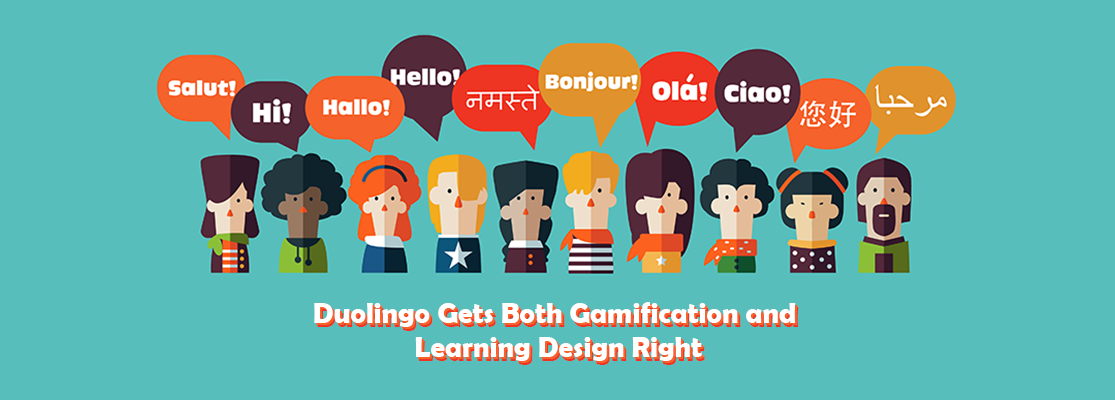DUOLINGO GETS BOTH GAMIFICATION AND LEARNING DESIGN RIGHT
We were collecting examples for a gamification webinar we conducted last September, and I was intrigued to know about Duolingo, the gamified language learning app. I downloaded the app immediately, but though it listed over 20 languages, there was none that I specifically wanted to learn. The intrigue intensified as I read about its features and rave reviews, but at that point, I had no time to experience the app by learning a new language, so I went ahead and delivered the webinar, citing Duolingo as an example of gamification done right. I gathered this much from users and gamification experts alike.
But Duolingo remained at the back of my mind. Recently I came across an article which cited a research finding that the “brain networks had become better integrated, which means they’re more flexible and allows for faster and more efficient learning”. This caught my attention. Who doesn’t like to become smarter, better integrated etc. :)? So I decided to check it out.
I wasn’t particularly interested in any of the languages on offer (by the way, did I mention that Duolingo is entirely free?), so I randomly chose Spanish. English, of course, remained my source language, the language through which I would be learning Spanish.
And here’s what I experienced:
When you start, you get to decide on your goals – the amount of work you want to put in everyday; choosing from:
- Casual (10 XP per day)
- Regular (20 XP per day)
- Serious (30 XP per day)
- Insane (50 XP per day)
(XP, or experience points, are awarded to you for completing lessons.) I chose casual, which meant I would have to spend 5-10 minutes a day, completing a single lesson each day.
When you reach your goal a few days in a row, you get a streak, which you have to work to maintain. For example, if you miss a couple of days’ lessons, your streak goes down. Streak basically refers to your knowledge of words in that lesson, and if you don’t keep up, it means you are forgetting those words, therefore your streak weakens to indicate that. Makes perfect sense. Did I hear someone say forgetting curve :)?
Duolingo sends regular reminders to meet your daily goal, encouraging you to reach longer learning streaks. These reminders are fun and personalized, suggesting what you will be learning next, and motivating you to keep practicing.
As you complete lessons and gain XP, you level up, earning lingots. Lingot is a virtual currency that allows you to buy various things from a store, right from dressing up your owl (the Duolingo mascot), to power ups and extra lessons. Currently none of these ‘items on display’ sound interesting to me, so I haven’t ventured into any shopping as yet.
Progress indicators are all over the place in Duolingo. The lessons are arranged based on a virtual skill tree, and keep coloring as you advance. Within each lesson, you get to see how many more questions you have to answer, as well as how many you got right in a row.
I haven’t practiced for more than a week now, and here’s what my progress looks like.
Duolingo is highly social. You can comment on and discuss specific questions from lessons, and get answers from others in the community. I’ve found this feature to be especially useful, in the absence of ‘why this works the way it works’ explanations from Duolingo.
You can add friends from your networks, and have a leaderboard comparing your score (XP) with theirs. You can also see what they’ve been up to, including their latest comments, who they are following and who is following them, as well as levels gained.
Cross a certain level, and you get a badge, which you can share on your social network. For the record, I’m 7% fluent in Spanish as I’m writing this post.
A much-touted feature is the Immersion area, which asks you to translate some text in a collaborative space, thereby helping you practice your language skills even more, and awarding you XP incentives for participation and contribution.
The lessons themselves are designed really well. No theory, no grammar rules, just a multi-modal learning system which uses visual and auditory cues to help you learn new words.
You start on the lower end of a skill tree, learning really simple words first, and then naturally and effortlessly progress towards more complex terms and constructs.
Repetition, a huge factor for success of any learning, language learning especially, has been used very effectively in Duolingo. Words and phrases you learned in Lesson 1 reappear in Lesson 3, in newer avatars, and in new constructs. Unconsciously you begin internalizing them.
Having said all that, the app is not without its flaws. My biggest gripe, from a learning design perspective, is the blatant implausibility of distractors. Many a time, the correct answer is a dead giveaway, either due to the construct, or some silly reason like punctuation. Check out the screenshot below.
- Looking at the choices, I’m pretty sure the sentence has to start with ‘No’ because that is the only word which is in title case. (In this case, the word is obvious, in others, it’s not.)
- When I’ve dragged four words to form a sentence, it’s way too obvious that the fifth word is ‘cook’, since that is the only verb, amongst the remaining options.
But despite such shortcomings, Duolingo is one fantastic language learning experience, neatly wrapped in a ‘gamified’ package. I hope and crave for more learning experiences to be designed so well.
¡Buen trabajo Duolingo! ¡Seguid así!
Written by Srividya Kumar
(Co-Founder at Learnnovators)
_________________________________
Published on 27-Jan-2017








